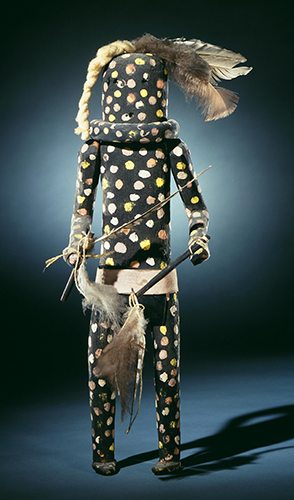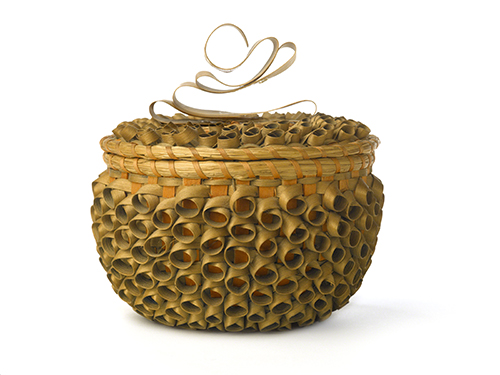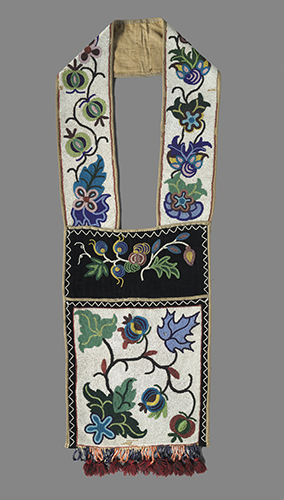Indigenous Peoples Heritage Month: Zuni Pueblo, Abenaki, Chippewa
On Monday I showed you ancient architecture and ceramics as part of my National Native American Heritage Month 2019 series. Today the series continues with a look at three objects from the 1800s.
 |
| Zuni Pueblo Culture (New Mexico), Shulawitsa Kohana (Fire God) Katsina, ca. 1800s. Wood, feathers, cotton, hide, silk, pigment and iron, 17 5/16" x 5 ½" (44 x 14 cm). © 2019 Brooklyn Museum. (BMA-101) |
Katsinam are traditionally carved from cottonwood root. They were originally carved only by the Katsinam dancers and used exclusively within Zuni and Hopi societies. However, since the late 1800s, they have also been made and sold to the general public as art objects.
Traditional Zuni religion recognizes three main deities, Earth Mother, Sun Father, and Moon Mother. Besides these are the spirits called katsinam (katsina or kachina, singular). Katsinam have been an integral part of Zuni, as well as Hopi, religious beliefs. Like those of the Hopi, Zuni katsinam are benevolent spirit beings in nature. The katsinam are often represented as small wooden sculptures and have special ceremonies and festivals associated with them. Two important festivals occur at the winter solstice (December) and shortly after the summer solstice (July).
Shulawitsa, the Zuni fire god, is similar to the Hopi Kokosori fire god, but not related. An innocent young man usually performs him at the Shalako ceremony during the winter solstice, which celebrates successful crops. The dancer carries a fire stick representing fire, an important physical element of the earth. His body and mask are painted black and covered in multicolored dots that represent seeds. He usually carries a deerskin bag full of seeds that will be blessed for the coming spring planting.
During the dances and ceremonies, katsinam are given by the Katsina dancers to infants of both sexes, young girls and women, and especially young women who are about to be married. The katsina is treated with great respect and is hung from a beam or wall so that it can benefit the entire family.
The Zuni culture of New Mexico are descendants of the ancient Anasazi culture, believed by archeologists to have moved to the Southwest well before 2500 BCE. They speak a unique language among the nineteen Pueblo cultures of New Mexico, and are regarded as one of the least changed Native cultures of North America. Historically the Zuni are a peaceful people who have avoided warfare with other bands.
 |
| Abenaki Culture, Basket, from the northeastern US or Canada, 1850–1900. Ash and pigment, 3 ¼" x 5" x 5" (8.3 x 12.7 x 12.7 cm). © 2019 Brooklyn Museum. (BMA-3392) |
Basketry is an art form that dates from the earliest times of First Nations and flourishes to this day. Particularly in the western US, basketry fragments that are thousands of years old have been found in archeological excavations.
The three major basketry forms are: 1) plaiting, where the weft (horizontal element) simply passes over and under a vertical warp; 2) twining, in which two or more weft elements are twisted around the warps to create patterns; and 3) coiling, in which spiraling foundation of rods or filaments is stitched together horizontally.
Abenaki baskets are typically formed from a base of interwoven warp strips. Most Abenaki baskets are made from plaited black ash wood, the preferred medium of Abenaki artists. After a tree is felled, the bark is removed and the trunk is pounded to separate the annual growth rings. Black ash is the only tree in which the wood separates this way.
After the rings are removed, a cleaver is used to detach the splints that will form the weft of the basket. The splints are planed to make them thinner and more flexible. Basket artists often wet them with their tongue in order to make them even more supple to achieve curlicue decoration seen on this basket.
The Abenaki culture is a branch of the Algonquian-speaking First Nation cultures of the northeastern United States and southern, French-speaking Canada. The Abenaki, along with the Maliseet, Passamaquoddy, Micmac, and Penobscot peoples, were originally members of the Wabanaki Confederacy, adversaries of the Iroquois.
During the 1600s and early 1700s, diseases brought by European colonists and military attrition by both French and British colonists reduced the Abenaki population by almost seventy-five percent. Many Abenaki who fled hostilities moved to Canada, and dozens of groups merged, thereby blurring the lines between individual cultural identity. By the 1870s, the Abenaki sought to reclaim their lands in New England, to no avail.
Presently, about 10,000 people of Abenaki heritage live in New England—the Sokoki and Mazipskwik Abenaki of Vermont and the Cowasuck of Massachusetts. Like many of the native bands forced aside by white settlement, the Abenaki began, during the early 1900s, to produce traditional baskets as a trade item to ensure a steady income for the culture.
 |
| Chippewa Culture, Bandolier bag, 1880s–ca. 1900. Glass beads, cloth and velvet, 42 ¼" x 13" (107.3 x 33 cm). © 2019 Cleveland Museum of Art. (CL-237) |
Beautifully decorated bandolier bags are a typical art form of many Woodlands bands, particularly among the Ojibwa and Potowatami. The bandolier bag is worn over the shoulder and across the chest. The bags, which are made by women, can take up to a year to complete. They are made to honor the deeds of certain members of the band who are related to the midewewin, or “great medicine society.”
Traditionally the bags were used to carry personal possessions and food for journeys. The simple act of wearing such a beautifully decorated bag was a badge of honor for the wearer. Although they were originally intended to be carried exclusively by men, women occasionally wore the bag for a brother, husband, or son who had died, or in the place of a man who needed healing.
Among the Woodlands bands, traditional beads were made from shell. The beads of this bag are glass beads, which became readily available to First Nations from white settlers. Traditionally the bags were decorated with geometric patterns. Artists who created abstracted floral patterns such as this one were influenced by European and American styles.
The Ojibwa (Ojibwe or Chippewa) is the largest group of First Nations people north of Mexico, and the third largest in the United States. They are equally divided between the US and Canada. The Ojibwa traveled widely across the continent for thousands of years. Eventually they began to migrate west along the Saint Lawrence River to the Great Lakes. The western group of the Ojibwa gradually expanded to the southern shore of Lake Superior. This group is called the Plains Ojibwa.
First historical contact with European settlers was with French traders in 1640. By the end of the 1700s, the Ojibwa were unchallenged “owners” of almost all of present-day Michigan, northern Wisconsin, Minnesota, and the entire north shores of Lakes Huron and Superior. Today more than 100,000 are living in land from Michigan to Montana, and from western Québec to eastern British Columbia. They were traditionally known for artwork in birch bark, cowrie shells, wild rice, and copper points.
Correlations to Davis programs: A Global Pursuit 2E: 2.5; Discovering Art History 4E: 4.10; Discovering Art History Digital: 4.10; The Visual Experience 3E: 14.5


Comments